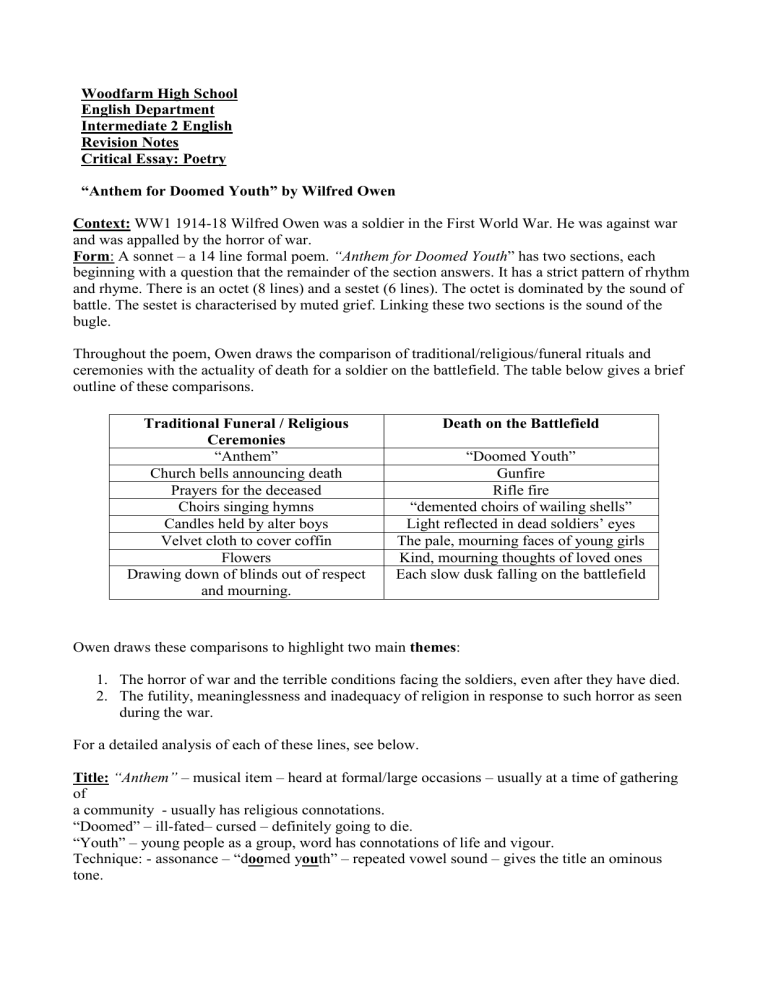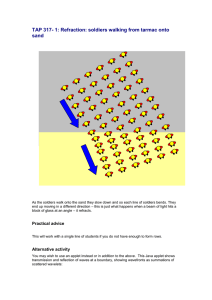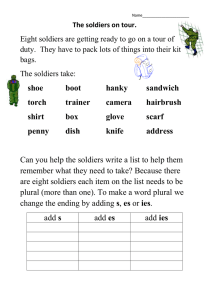Anthem for Doomed Youth Notes
advertisement

Woodfarm High School English Department Intermediate 2 English Revision Notes Critical Essay: Poetry “Anthem for Doomed Youth” by Wilfred Owen Context: WW1 1914-18 Wilfred Owen was a soldier in the First World War. He was against war and was appalled by the horror of war. Form: A sonnet – a 14 line formal poem. “Anthem for Doomed Youth” has two sections, each beginning with a question that the remainder of the section answers. It has a strict pattern of rhythm and rhyme. There is an octet (8 lines) and a sestet (6 lines). The octet is dominated by the sound of battle. The sestet is characterised by muted grief. Linking these two sections is the sound of the bugle. Throughout the poem, Owen draws the comparison of traditional/religious/funeral rituals and ceremonies with the actuality of death for a soldier on the battlefield. The table below gives a brief outline of these comparisons. Traditional Funeral / Religious Ceremonies “Anthem” Church bells announcing death Prayers for the deceased Choirs singing hymns Candles held by alter boys Velvet cloth to cover coffin Flowers Drawing down of blinds out of respect and mourning. Death on the Battlefield “Doomed Youth” Gunfire Rifle fire “demented choirs of wailing shells” Light reflected in dead soldiers’ eyes The pale, mourning faces of young girls Kind, mourning thoughts of loved ones Each slow dusk falling on the battlefield Owen draws these comparisons to highlight two main themes: 1. The horror of war and the terrible conditions facing the soldiers, even after they have died. 2. The futility, meaninglessness and inadequacy of religion in response to such horror as seen during the war. For a detailed analysis of each of these lines, see below. Title: “Anthem” – musical item – heard at formal/large occasions – usually at a time of gathering of a community - usually has religious connotations. “Doomed” – ill-fated– cursed – definitely going to die. “Youth” – young people as a group, word has connotations of life and vigour. Technique: - assonance – “doomed youth” – repeated vowel sound – gives the title an ominous tone. Commentary: The title of the poem gives the reader the impression that they are about to hear a formal musical item. The fact that the “youth” are “doomed” is clearly wrong. The musical item does not materialise, as we are led by the poet into the battlefield to hear the sounds of war, rather than the music of a memorial service. Line-by-line Analysis L1. “What passing bells for these who die as cattle?” The poem opens with a question – asking what sign/signal will be sounded to mark the death, the “passing” of the soldiers. The manner of their deaths is being compared to the mass slaughter of animals. “passing-bells” – bells tolled to announce a death, to call the people to mourn . “as cattle” – the deaths are impersonal, mass, in a group. Connotations of slaughter. Commentary – the poet’s opinion is clear from the outset. He is appalled by the inhumane deaths these young men experience. He feels as if they are nameless and faceless – losing their identities in the chaos of war. They die together – brutally and mechanically. They line up and are helpless in the face of their enemy. L2. “Only the monstrous anger of the guns” “only” – what they hear is not enough sufficient as a “passing bell”, considering what they will have suffered. “monstrous” – connotations of- evil, horror “anger of the guns” – transferred epithet – the anger of the enemy soldiers is transferred into their weapons, creating a metaphor, personifying the guns that become “angry”. Commentary – Instead of a bell, calling people to mourn for the lives of these individuals, the sound is one of “monstrous anger”. The anger is misplaced – transferred onto the weapons which spit their hatred at the soldiers. The anger is “monstrous” - unfitting, grotesque and obscene. To be monstrous also suggests that the sound is loud, as if a huge monster is roaring angrily. L3, 4. “Only the stuttering rifles’ rapid rattle Can patter out their hasty orisons.” Repetition of “Only” showing in more detail what the monstrous anger of the guns sounded like. Alliteration and onomatopoeia used to imitate the sound of the guns – harsh, repetitive. The repeated “t” sound in “stuttering”, “rattle” and “patter” imitate the short, hard sound of the bullets being fired. The repeated “r” sound suggests the rapidity and frequency of the shots. “patter out” – rapidly speak “hasty” – rushed, fast “orisons” – prayers Commentary - The personified guns are rattling out prayers – but these prayers are not for the good of the soldiers as they die. The noises made, being bullets, lead to their death. So the question from the first line is answered: What bells will be rung for them? The sound of guns, the sound of bullets: – quick, harsh and repetitive. Religious acts are seen to be inadequate here prayers are rapidly spoken – perhaps thoughtlessly. Orisons are described as “hasty” – rushed. Line 5 – 7 “No mockeries now for them; no prayers or bells: Nor any voice of mourning save the choirsThe shrill demented choirs of wailing shells:” “Mockeries” – ceremonies which would be insults to them and what they have sacrificed. “Prayers”/”bells” – traditional funeral rites. “No”, “no”, “nor” – repetition emphasises what they do not have. “”Save – except – he goes on to describe what they do get in place of a funeral “Shrill” – high pitched – piercing. Connotations - uncomfortable to hear, unpleasant “Demented” – crazy – sounds mad. “Choirs” – group who sing in harmony, having rehearsed together. Harmony is usually pleasant – in a choir they plan and work together. “Wailing” – in pain, crying, sorrow, lamenting – onomatopoeia. The word “wailing” imitates the sound of the shell as it travels. It is an appropriate description, given the death all around. “Shells” – explosive projectiles from a cannon. Commentary-. In the battlefield, the overall impression would be harsh and discordant, making the listeners wince. This is why the choirs are described as “shrill” and “demented” – it is a mad and horrific cacophony of sound. Just as the bullets pray, the shells grieve in their “wailing”. This develops the idea of the noise of battle from the opening lines. The guns and shells build up together to create for us the atmosphere of the battle – a disorienting mix of sounds that are the tragic reality for the soldiers at the moment of their deaths. Again the inadequacy of religion’s response to this mass death is noted – their prayers and bells that usually suffice are nothing but “mockeries” to these soldiers. Line 8 – “And bugles calling them from sad shires” “Bugles” – a bugle is a small valveless trumpet – used to mark times of day in barracks. Would also be sounded at funerals. Would be sounded to call a retreat. “Sad shires” – a reference to the places the soldiers would have come from. This is the first reference away from the battlefield. The bugles are “calling them” – showing us that although they are dying a nameless, faceless death, some people are waiting and hoping for them. Commentary – the last sound of battle is the sound here of the bugles being sounded to call the soldiers home. In the Owen’s mind the bugles call the instruction that those at home would call – to get out of the madness of war. The bugles are mixed with the guns and bullets in the confusion of the battle. Line 9 “What candles may be held to speed them all?” Commentary -This is the second question asked and this indicates a shift in the poem’s focus. We now know what “passing-bells” they will have – it will be the sound of the chaos of battle. He now develops the idea of comparing a right and fitting death to a death in war – without ceremony, without traditional rites and without dignity. “Candles” – people would light candles in churches perhaps to show they were remembering their father/husband/son. At a funeral, the candles would be a sign of the hope of an afterlife, they would be wished well on their way. “Speed” – to send forth with good wishes – to bring to an end. They would be sending them off. Line 10, 11 – “Not in the hands of boys but in their eyes Shall shine the holy glimmers of goodbyes.” Commentary – Instead of candles being held to send them on their way into the afterlife, the soldiers simply have the last flicker of light in each other’s eyes before they die. In this image, candles are being compared to small “glimmers” of light in the eyes of the soldiers. They both bear a tiny, but holy light. Line 12 “The pallor of girls’ brows shall be their pall” “Pallor” – paleness of complexion “Girls” – these will be the girls they have left at home “Pall” – the cloth placed over a coffin (sometimes a flag) as it arrives in a church. Commentary – The soldiers will not have a sheet/pall/flag placed over their coffin. They may never have a proper burial. They will not be transported home for their own funeral. The pall will be absent from their funeral. The pall would be draped over the coffin before burial. The absent pall is metaphorically replaced with the grief of girls at home. They would hear of the death and be pale. This paleness – representative of the angst of the mourners - would be seen on their brows/foreheads. Line 13 “Their flowers the tenderness of patient minds.” “Flowers” – a tribute to the dead, a mark of respect, a thing of beauty contrasting the uglinessof death. Commentary - Another metaphor. Again, as in the previous two images, they will not get flowers as you traditionally would at a funeral. In place of floral tributes, they have people thinking about them. The people’s thoughts are respectful and positive in place of flowers. Line 14 “And each slow dusk a drawing down of blinds.” Alliteration –– “dusk a drawing down” - atmosphere of dull stillness – death and coming to a close. “blinds” - People draw down the blinds at night as a preparation for sleep. Also the blinds would have been drawn in a room a dead person had been laid. “Dusk”: partial darkness, evening time Commentary – This is the last of these comparisons – “candles”, “pall”, “flowers” – and the last usual funeral custom is the “drawing down of blinds”. Traditionally the blinds are drawn when someone dies. It is a sign to the world and a mark of respect for them. Instead of blinds being drawn around a dead person, the soldiers lying dead on the battlefield would simply have the day draw to a close. “Dusk” would come naturally, darkening the place where they lay. Summary “Anthem for Doomed Youth” was written by a soldier, Wilfred Owen, who died in the last week of the Great War. His poem clearly communicates the sorrow and horror he experienced during that war. In the poem, the noise of battle gives way to silent grief. Young men who should have lived died in the chaos of battle. Those who lost loved ones were not present at the deaths or burials of their young men. In place of the usual funeral rites, sounds of battle, distant grief and nature’s close of day were what they had to mark their deaths. Throughout the poem, Owen employed imagery to bring to life the sorrow and horror of war – by describing the sounds and sights, by comparing a fitting funeral to the reality of death in war and by questioning the sufficiency of religion to provide solace in the face of such brutality.


